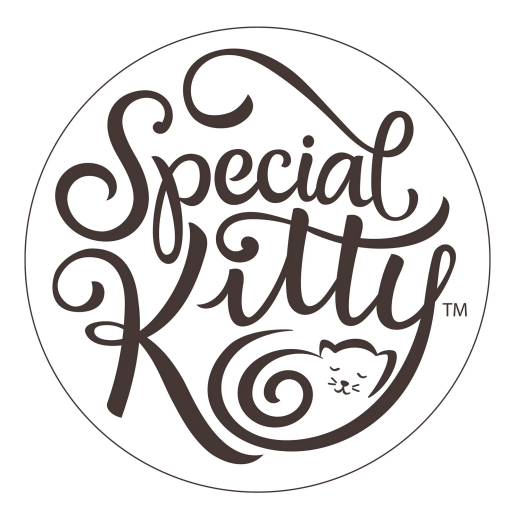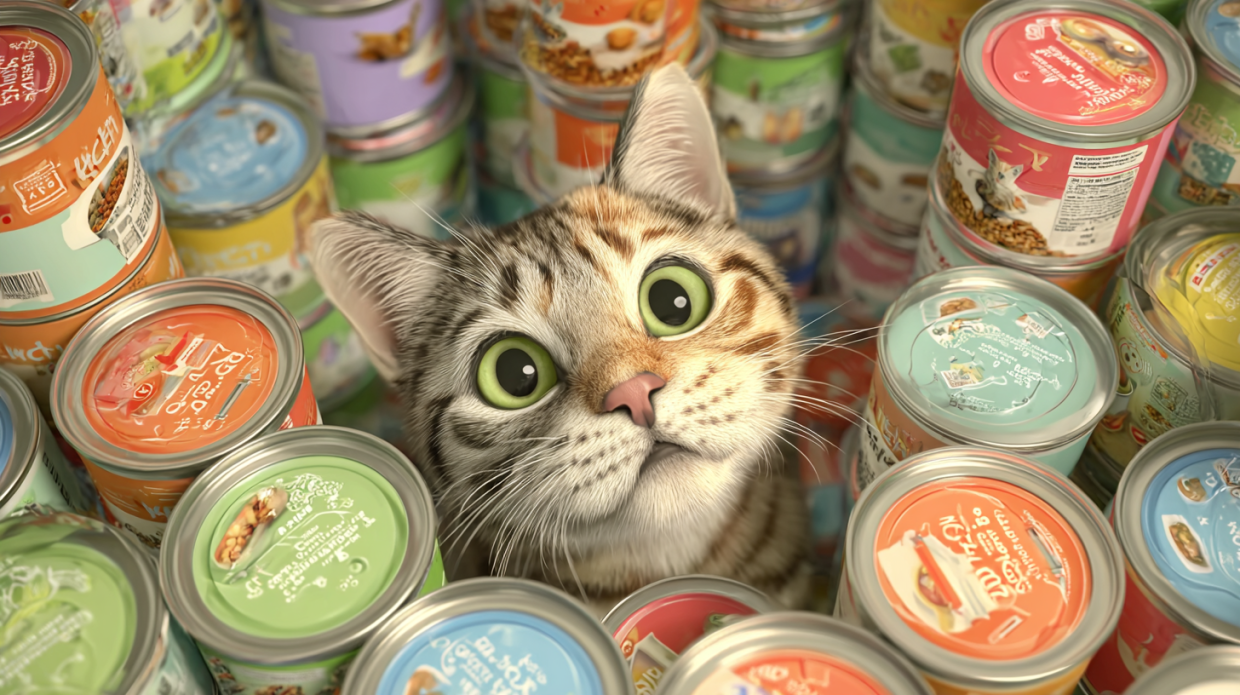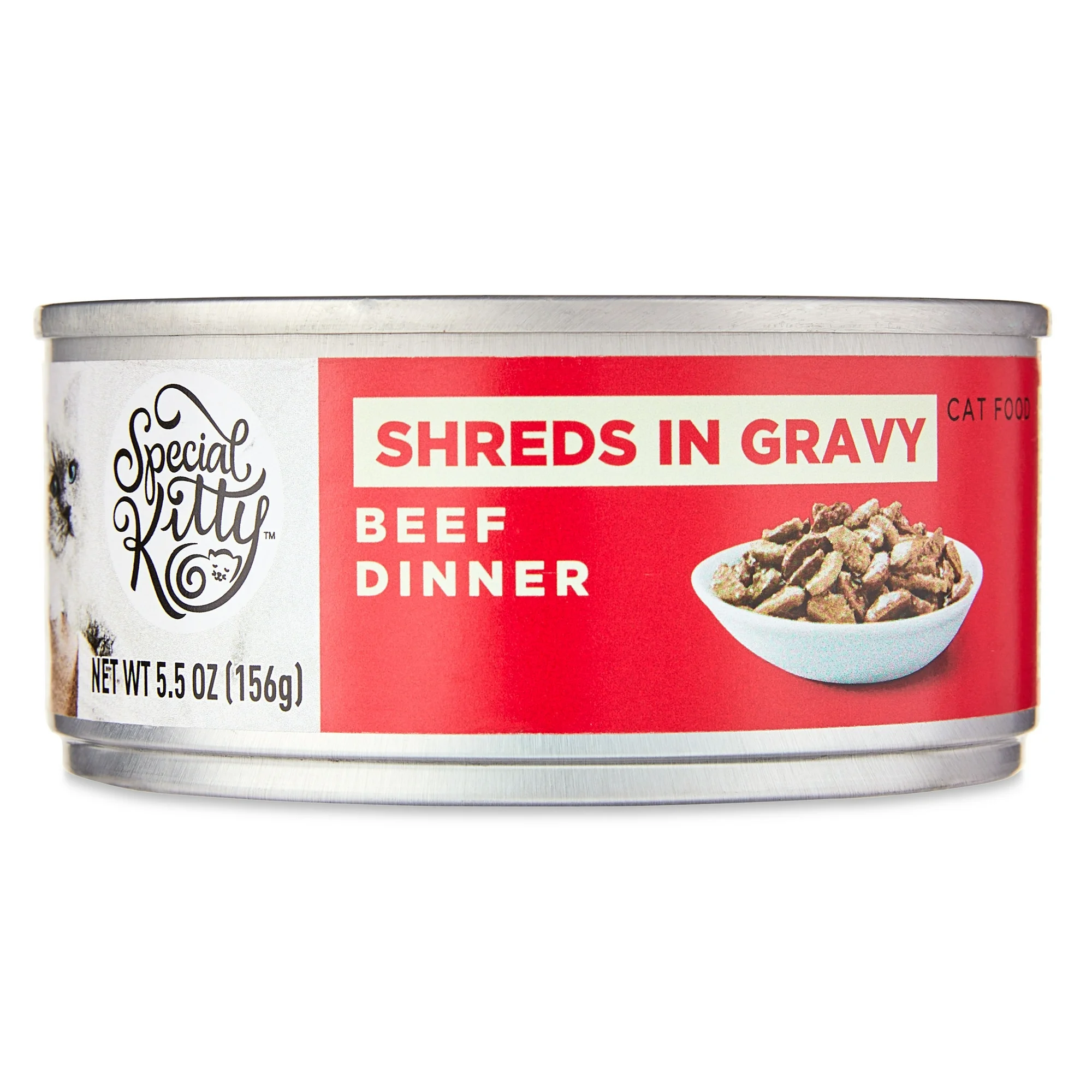
Special Kitty Beef Dinner Shreds in Gravy Wet Cat Food, 5.5 oz Can
- Special Kitty Sliced Beef Dinner
- Easy feeding instructions provided on the pack
- Pull-tab-lid can allows for easy opening
- Helps keep your cat hydrated
- 100% complete and balanced nutrition
$0.57
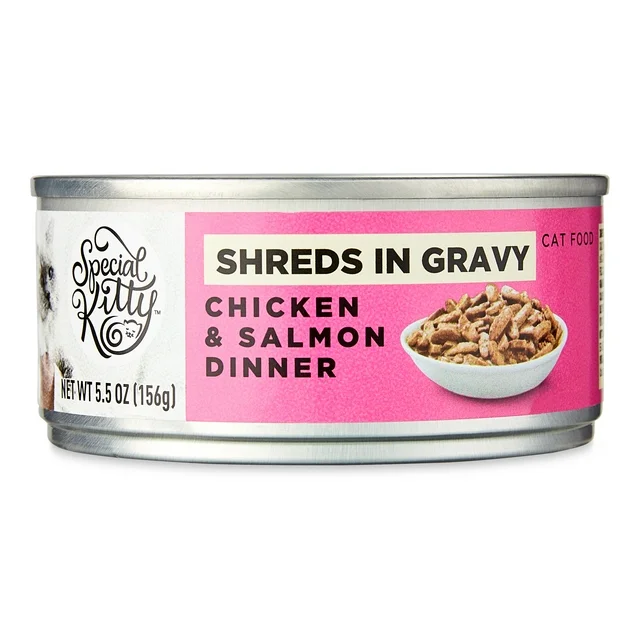
Special Kitty Chicken & Salmon Dinner Shreds in Gravy Wet Cat Food, 5.5 oz Can
- Special Kitty Chicken and Salmon Dinner in Gravy 5.5OZ
- Delicious flavor your cat will love
- Easy feeding instructions provided on the pack
- Pull-tab-lid can allows for easy opening
- Helps keep your cat hydrated
- 100% complete and balanced nutrition
$0.57
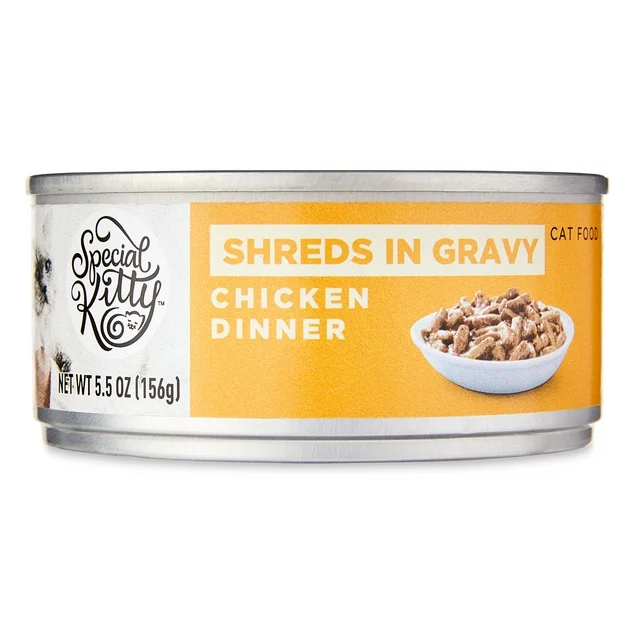
Special Kitty Chicken Dinner Shreds in Gravy Wet Cat Food, 5.5 oz Can
- Special Kitty Sliced Chicken Dinner CIG 5.5OZ
- Easy feeding instructions provided on the pack
- Pull-tab-lid can allows for easy opening
- Helps keep your cat hydrated
- 100% complete and balanced nutrition
$0.57
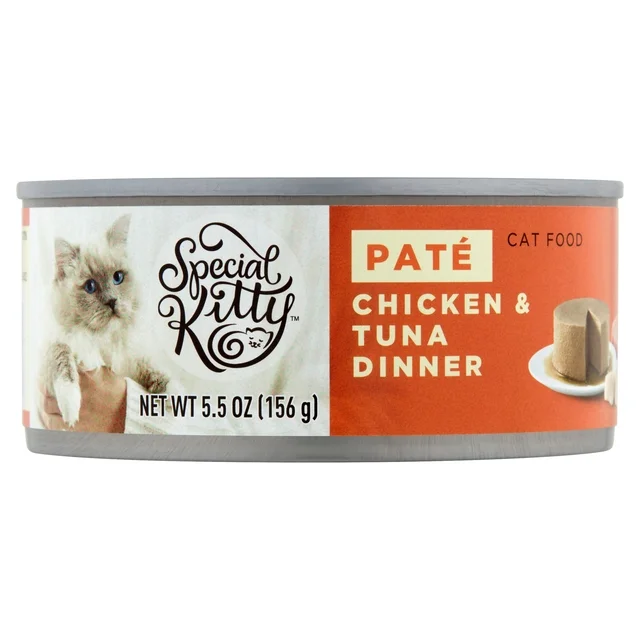
Special Kitty Chicken & Tuna Dinner Pate Wet Cat Food, 5.5 oz Can
- Special Kitty Chicken & Tuna Dinner Pate Wet Cat Food, 5.5 oz:
- Moist and tender wet food
- Chicken and tuna pate flavor your cat will love
- Easy feeding instructions provided on the pack
- Pull-tab-lid can allows for easy opening
- Helps keep your cat hydrated
- 100% complete and balanced nutrition
$0.57
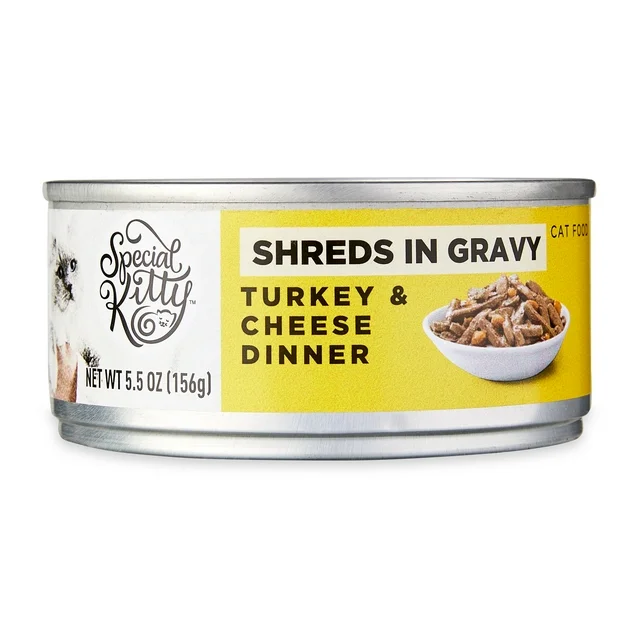
Special Kitty Turkey & Cheese Dinner Shreds in Gravy Wet Cat Food, 5.5 oz Can
- Special Kitty Turkey and Cheese Cuts and Gravy 5.5OZ
- Delicious flavor your cat will love
- Easy feeding instructions provided on the pack
- Pull-tab-lid can allows for easy opening
- Helps keep your cat hydrated
- 100% complete and balanced nutrition
$0.57
Navigating the World of Budget-Friendly Feline Nutrition Without Compromising Quality
As a dedicated cat parent to three very opinionated furballs, I’ve spent countless hours researching, testing, and sometimes desperately trying to find cat food that satisfies both my budget concerns and my cats’ finicky palates. Today, I want to share my journey with Special Kitty canned cat food – a brand that has become a staple in our household through trial, error, and more than a few midnight “emergency” runs to Walmart when we’ve run out of food and faced the dreaded empty-bowl meows.
The search for affordable yet nutritious cat food is something many of us face, and finding the balance between quality and cost is the ultimate challenge for responsible pet owners. Let me walk you through everything I’ve learned about Special Kitty canned cat food, from ingredients to value, so you can decide if it’s the right choice for your feline companion.
What Exactly Is Special Kitty Canned Cat Food?
When I first stumbled upon Special Kitty canned cat food during a particularly tight month financially, I was admittedly skeptical. As Walmart’s private label cat food brand, Special Kitty has been around for decades, quietly serving as a budget-friendly option for cat owners across America.
The brand offers a variety of wet food options in those familiar small cans that my cats now recognize the sound of opening from three rooms away. Special Kitty positions itself as an affordable solution that doesn’t sacrifice essential nutrition – a claim I initially approached with the wariness of someone who’s heard marketing promises before.
What I’ve come to appreciate is the straightforward approach of the brand. Special Kitty doesn’t pretend to be a premium boutique option with exotic ingredients sourced from the far reaches of the globe. Instead, it focuses on providing complete and balanced nutrition at a price point that won’t have you checking your bank account before heading to the checkout line.
The cans typically contain 5.5 ounces of food, which is fairly standard in the industry. The distinctive label with its playful cat silhouette has become immediately recognizable to me after years of stocking my pantry with these cans.
The Big Question: Is Special Kitty Canned Food Actually Good for Cats?
Let’s address the elephant – or rather, the cat – in the room. Is budget-friendly Special Kitty canned food actually good for our beloved pets? This question kept me up at night when I first considered making the switch from more expensive brands.
After extensive research and consultation with my veterinarian (who has probably grown tired of my endless cat food questions), I’ve reached a nuanced conclusion: Special Kitty canned food provides adequate nutrition for healthy adult cats, though it may not be the ideal choice for cats with specific health conditions or dietary needs.
The food meets AAFCO (Association of American Feed Control Officials) nutritional standards, which means it contains the minimum required nutrients for adult cat maintenance. This is crucial because it ensures that your cat is getting the basic nutrition they need.
I’ve noticed that my oldest cat, Pepper, actually has a shinier coat since we incorporated Special Kitty into her rotation. However, my middle cat, Luna, who has a sensitive stomach, sometimes does better with other brands specifically formulated for digestive issues. My youngest, Oliver, would eat cardboard if I put it in his bowl, so he’s not the best measure of quality!
From a veterinary perspective, wet food in general offers benefits over dry food due to the higher moisture content, which supports urinary tract health. So feeding Special Kitty canned food already gives you an advantage over exclusively dry diets.
Breaking Down the Ingredient List
Ingredient labels can feel like reading a foreign language sometimes, but I’ve become somewhat of an amateur pet nutritionist over the years. Here’s what I’ve learned about Special Kitty canned food ingredients:
The primary ingredients in most Special Kitty canned varieties include meat by-products, water sufficient for processing, and various meat sources (chicken, turkey, fish, depending on the flavor). Yes, “meat by-products” doesn’t sound appetizing to human ears, but it’s important to understand that these include organ meats that cats would naturally consume in the wild.
The food does contain some fillers and thickeners like wheat gluten or modified corn starch in many varieties. This is one area where premium brands typically differ, offering grain-free options with fewer fillers.
Special Kitty also includes taurine in their formulation, which is absolutely essential for cats. Taurine deficiency can lead to serious health problems including heart disease and vision issues, so I always check for this amino acid when evaluating cat food.
One aspect that gave me pause initially was the presence of artificial colors in some varieties. Cats don’t care what color their food is, so these additives serve no nutritional purpose and are purely for human marketing. However, the quantities are minimal.
The food is fortified with vitamins and minerals to ensure nutritional completeness. This includes vitamin E, vitamin A, thiamine, and various B vitamins that support overall health.
While not boasting “human-grade” ingredients like some premium brands, Special Kitty provides the fundamental nutrients cats need. I’ve learned to be pragmatic – while I’d love to feed my cats the feline equivalent of organic, locally-sourced gourmet meals, my budget appreciates the more reasonable approach Special Kitty offers.
A Flavor for Every Feline: Special Kitty Variety Options
If there’s one thing I’ve learned as a cat parent, it’s that cats develop very definite preferences when it comes to flavors and textures. The day Pepper decided she would no longer eat chicken after three years of happily consuming it still baffles me.
Special Kitty offers a surprisingly diverse range of flavors, which has been a saving grace in our multi-cat household. Their lineup includes:
- Classic ocean whitefish & tuna feast
- Savory salmon dinner
- Turkey & giblets dinner
- Mixed grill
- Super supper
- Tender beef & poultry
- Seafood dinner
They also offer different textures, primarily pâté style and chunks in gravy. This variety has been crucial in our house – Oliver exclusively eats pâté while Luna turns her nose up at anything that isn’t in gravy. Cats, am I right?
One thing I appreciate is that Special Kitty doesn’t go overboard with exotic-sounding flavors that might confuse cats. They stick to protein sources that cats typically enjoy and recognize. When I’ve tried some of the more creative flavors from premium brands (like “chicken wellington with garden vegetables”), my cats have given me looks that clearly communicated their feline disdain.
Through much trial and error, I’ve discovered that my cats prefer the seafood varieties, particularly the ocean whitefish & tuna. Your mileage may vary – I’ve heard from friends whose cats exclusively prefer the poultry options. The joy of cat ownership is discovering these unique preferences through a process of careful observation and occasionally cleaning rejected food off the floor.
Let’s Talk Money: The Cost Factor
Let’s be honest – one of the most compelling reasons to consider Special Kitty is the price point. In today’s economy, with inflation affecting everything from housing to pet care, finding ways to maintain quality while managing costs is increasingly important.
Special Kitty canned food typically costs between $0.50-$0.70 per 5.5-ounce can, depending on where you shop and whether you catch any sales. This price point is significantly lower than premium brands that can run $1.50-$3.00 per can of similar size.
For perspective, feeding an average 10-pound adult cat exclusively Special Kitty canned food might cost around $1.00-$1.40 per day, while premium brands could easily run $3.00-$6.00 daily. Over a year, that difference adds up to hundreds of dollars – money that can go toward other aspects of pet care like preventative veterinary visits or that ridiculous cat tree I recently splurged on (which, naturally, they ignore in favor of the cardboard box it came in).
When purchasing in bulk or multi-packs, the savings become even more substantial. I’ve found that the 24-can variety packs offer the best value, and the mixed flavors help prevent the food fatigue that sometimes happens when cats eat the same thing day after day.
I’ve occasionally found Special Kitty on sale or with coupons, further reducing the cost. Walmart frequently offers rollback prices on pet food, and I’ve signed up for their pet parent email list to get notifications of upcoming sales. Being strategic about purchases has helped me maximize value while ensuring my cats never face an empty food bowl.
Where to Find Special Kitty Canned Cat Food
As Walmart’s private label brand, Special Kitty is most readily available at Walmart stores and through Walmart.com. This exclusivity has both advantages and disadvantages.
The main advantage is consistency – if you have a Walmart nearby, you can count on finding the product regularly. I’ve developed the habit of checking stock whenever I’m in the store, even if I don’t immediately need cat food, to avoid those last-minute emergencies.
The downside is limited availability if you don’t live near a Walmart. In more rural areas, this can be challenging. I learned this the hard way during a family visit to a small town where the nearest Walmart was 45 minutes away, and my cats were unimpressed with the alternative options I scrambled to find.
Online ordering through Walmart.com has been a game-changer for me, especially with their subscription option that ensures regular deliveries. The “Subscribe & Save” feature usually offers a small additional discount and prevents those “Oh no, we’re out of cat food!” moments that inevitably happen at inconvenient times.
I’ve occasionally found Special Kitty at some dollar stores as well, though the selection is typically more limited. If you’re in a pinch, it’s worth checking these alternative locations.
Is Special Kitty Suitable for Kittens?
When I adopted Oliver as a kitten two years ago, I wondered if I could simply feed him the same Special Kitty canned food that my adult cats were eating. After consulting with my veterinarian, I learned some important distinctions.
Most Special Kitty canned food varieties are formulated for adult maintenance, not for growth and development. Kittens have specific nutritional needs, particularly higher protein and calorie requirements to support their rapid growth.
The standard Special Kitty products don’t provide the optimal nutrition that growing kittens need. I ended up feeding Oliver a kitten-specific formula from another brand until he reached about 10-12 months of age, when he could safely transition to adult food.
That said, Special Kitty does offer a specific kitten formula in their dry food line, though not in their wet food options as of my last check. If you’re raising a kitten, I’d recommend either using a kitten-specific formula from another brand or consulting your veterinarian about supplementing Special Kitty adult wet food with appropriate nutrients.
During the transition period when Oliver was almost ready for adult food, I did occasionally mix small amounts of Special Kitty with his kitten food to help him adjust to the taste gradually. This worked well, and by the time he was fully on adult food, he was already accustomed to the Special Kitty flavors and textures.
Natural Ingredients: Fact or Fiction?
In an age where “natural” has become a marketing buzzword across industries, including pet food, it’s important to approach these claims with a critical eye. Does Special Kitty contain natural ingredients? The answer is: partially.
Special Kitty does contain natural meat ingredients and essential nutrients that cats would consume in a natural diet. However, it also contains processed ingredients, preservatives, and in some varieties, artificial colors and flavors that wouldn’t be considered “natural” by strict definitions.
The brand doesn’t position itself as an all-natural or organic option, so I don’t hold it to those standards. It’s important to align expectations with a product’s intended market position – Special Kitty aims to provide complete nutrition at an affordable price point, not to compete with premium natural brands.
That said, I’ve noticed improvements in their formulations over the years I’ve been purchasing the brand. There seems to be a gradual shift toward simpler ingredient lists across the pet food industry, and even budget brands are responding to consumer preferences for fewer artificial additives.
If a completely natural ingredient list is your top priority, you might need to look at other brands specifically focused on that niche, though expect to pay significantly more. For many of us balancing multiple priorities including budget, Special Kitty represents a reasonable compromise.
The Grain-Free Question
Grain-free diets became tremendously popular in pet food over the past decade, though recent veterinary research has raised some questions about their universal benefit for all cats. Where does Special Kitty stand on the grain-free spectrum?
Most Special Kitty canned varieties are not grain-free. They typically contain some grain-derived ingredients like wheat gluten or corn starch as thickening agents. This is one area where Special Kitty differs from many premium brands that offer grain-free options.
For most healthy cats, small amounts of grains in wet food aren’t problematic. Cats are obligate carnivores, meaning they require meat-based diets, but they can process limited quantities of carbohydrates. The moisture content of wet food also helps mitigate some concerns about carbohydrate consumption in cats.
If your cat has been diagnosed with a grain allergy or sensitivity (which is actually quite rare in cats, despite popular belief), Special Kitty would not be the appropriate choice. However, for cats without specific grain sensitivities, the limited grain content in Special Kitty wet food generally doesn’t pose health concerns.
I initially worried about this aspect when switching to Special Kitty, but after monitoring my cats for any adverse reactions and consulting with my veterinarian, I found that the grain content didn’t negatively impact their health. Luna, my cat with the sensitive stomach, occasionally gets grain-free food from other brands, but Pepper and Oliver do fine with Special Kitty’s standard formulations.
Special Kitty vs. Premium Brands: An Honest Comparison
Having tried everything from ultra-premium brands to grocery store options over my years as a cat parent, I feel qualified to make some honest comparisons between Special Kitty and higher-priced alternatives.
The most obvious difference is in the ingredient quality. Premium brands typically feature named meat sources as the first ingredient (like “chicken” rather than “meat by-products”), fewer fillers, and no artificial colors or preservatives. They often highlight novel proteins, limited ingredients, or specific health benefits.
Texture and consistency also differ. I’ve noticed that premium brands generally have a more consistent texture and appearance from can to can, while Special Kitty can occasionally vary slightly between batches. This hasn’t bothered my cats, but it’s something I’ve observed.
Packaging is another distinction. Premium brands invest more in attractive, high-end packaging with detailed information about sourcing and ingredients. Special Kitty keeps packaging simple and functional, which helps keep costs down but provides less “story” about the product.
In terms of palatability, the results might surprise you. My cats actually prefer certain Special Kitty varieties over some much more expensive brands I’ve tried. Cats don’t care about marketing or pretty packaging – they respond to flavor, aroma, and texture, areas where Special Kitty seems to have done their research.
Nutritionally, premium brands might offer slightly higher protein percentages or specialized formulations for specific health conditions. However, for healthy adult cats with no special dietary needs, the nutritional difference may not justify the significant price gap for many pet owners.
I’ve settled on a compromise approach in our household – Special Kitty forms the foundation of my cats’ wet food diet, supplemented occasionally with premium brands when budget allows or when I find good sales. This balanced approach helps me manage costs while still providing variety and occasional “upgrades” to their diet.
Safety First: Understanding Recalls
Product recalls are an unfortunate reality across the pet food industry, affecting brands at all price points. Being informed about a brand’s recall history is an important part of responsible pet ownership.
Special Kitty has had recalls over its long history, as have most established pet food brands. The most significant recent recall affecting some Special Kitty canned products occurred in 2019 due to potential foreign material contamination. There was also a limited recall in 2017 related to thiamine deficiency concerns in specific varieties.
I make it a practice to stay informed about pet food recalls by regularly checking the FDA’s pet food recall website and signing up for recall alerts through trusted pet safety organizations. This vigilance applies to all brands I feed my cats, not just Special Kitty.
It’s worth noting that the frequency of recalls isn’t necessarily higher for budget brands than premium ones. Some of the most expensive brands on the market have experienced significant recalls in recent years. The key factor is how transparently and promptly companies respond to quality concerns when they arise.
In my experience, Walmart has handled Special Kitty recalls responsibly, with clear communication and straightforward return policies. While no recalls are good news, the company’s handling of these situations has maintained my confidence in the brand.
Nutritional Completeness: Vitamins and Minerals
One area where Special Kitty deserves credit is in ensuring nutritional completeness through appropriate vitamin and mineral fortification. This is particularly important for budget brands, as it ensures cats receive essential micronutrients regardless of ingredient quality.
Special Kitty canned food is fortified with a complete spectrum of vitamins and minerals including:
- Taurine (essential for heart and eye health)
- Vitamin E (antioxidant protection)
- Vitamin A (vision and immune function)
- B vitamins (energy metabolism and nervous system function)
- Essential minerals like zinc, copper, and manganese
The AAFCO statement on Special Kitty packaging confirms that the food provides complete and balanced nutrition for adult cats, meaning it meets established nutritional standards for maintenance.
In monitoring my cats’ health over years of feeding Special Kitty, I’ve observed good energy levels, healthy coats, and normal biomarkers during veterinary checkups. While premium foods might use more bioavailable forms of certain nutrients or include additional supplements like omega fatty acids, the fundamental nutritional bases are covered by Special Kitty’s formulation.
My veterinarian has commented that many cat owners overfocus on brand prestige rather than ensuring nutritional adequacy. She emphasized that a consistent, complete diet – even from a budget brand – is preferable to inconsistently feeding premium food when finances fluctuate, potentially creating nutritional gaps.
Practical Matters: Storage and Shelf Life
The practical aspects of cat food – how long it lasts, how to store it, and how to manage leftovers – are often overlooked in discussions about nutrition but are important for everyday life with cats.
Unopened Special Kitty canned food typically has a shelf life of 2-3 years from the manufacturing date, which is printed on each can. I’ve developed the habit of checking these dates when purchasing and organizing my storage to use older cans first.
Once opened, an unused portion of Special Kitty should be refrigerated and used within 3-5 days. I’ve found that inexpensive plastic can covers work well for this purpose, though transferring leftover food to a small airtight container works even better for maintaining freshness and preventing odor transfer in the refrigerator.
I’ve noticed that Special Kitty has a slightly stronger aroma than some premium brands, likely due to the flavor enhancers used to increase palatability. This isn’t necessarily a negative – cats are attracted to strong food aromas – but it does mean proper storage is important to prevent your refrigerator from developing a distinct “eau de cat food” fragrance.
For convenience, I portion out half-cans when feeding just one of my cats, refrigerating the remainder immediately. This practice minimizes waste and maintains freshness better than leaving partially used cans at room temperature for extended periods.
Special Kitty’s standard 5.5-ounce can size works well for my household with three cats, but if you have just one cat, you might find yourself storing partial cans frequently. Some premium brands offer smaller 3-ounce cans that can be more convenient for single-cat households, though at a higher per-ounce cost.
Texture Options: Pâté vs. Chunks in Gravy
The eternal debate among cat owners often centers around food texture preferences. Some cats exclusively eat pâté, others demand chunks in gravy, and some particularly finicky felines (I’m looking at you, Luna) will switch preferences seemingly at random.
Special Kitty offers both primary texture types:
Pâté varieties have a smooth, consistent texture throughout the can. These include options like Classic Ocean Whitefish & Tuna Feast and Turkey & Giblets Dinner. The pâté options tend to be higher in protein concentration and lower in added moisture.
Chunks in gravy varieties contain distinct meat pieces suspended in sauce. These include options like Seafood Dinner in Sauce and Mixed Grill in Gravy. These typically have a slightly lower protein concentration by volume due to the added liquid, but many cats prefer the texture variation.
I’ve found that Special Kitty’s pâté textures are reasonably consistent, though occasionally slightly more firm or soft than premium brand equivalents. The chunks in gravy varieties sometimes have less defined chunks than premium options, with meat pieces that tend to break down more easily.
Through much experimentation, I’ve discovered that Oliver exclusively prefers pâté, Pepper enjoys both textures but slightly favors chunks in gravy, and Luna goes through phases where she’ll only eat one texture before suddenly switching to the other. This household complexity is why I always keep both texture types on hand.
If you’re just introducing Special Kitty to your cat, I recommend trying both textures to determine preference. Many cats have strong opinions about food texture that override flavor preferences.
Special Considerations: Cats with Sensitive Stomachs
Living with Luna, my middle cat with digestive sensitivity, has given me particular insight into how Special Kitty performs for cats with slightly delicate systems.
Special Kitty does not offer specific “sensitive stomach” formulations like some premium brands do. Their recipes contain common ingredients that may trigger reactions in truly sensitive cats, including various protein sources and thickening agents.
For Luna, I’ve found that some Special Kitty varieties work fine, while others trigger soft stools or occasional vomiting. The plainer varieties, particularly the turkey and chicken options with fewer ingredients, tend to work better for her than seafood or mixed protein varieties.
If your cat has diagnosed food sensitivities or inflammatory bowel issues, Special Kitty likely isn’t the ideal choice. Veterinary-recommended prescription diets or premium limited-ingredient diets would be more appropriate, despite the higher cost.
For cats with mild sensitivities like Luna, a careful trial of different Special Kitty varieties may identify options that work well. I keep notes in my phone about which specific flavors and textures cause issues for her, which has been invaluable in preventing digestive upsets while still incorporating some economical options into her diet.
Rotating proteins can also help prevent the development of food sensitivities in some cats. I try not to feed the same protein source for extended periods, which is easier with Special Kitty’s variety of flavor options.
Managing Weight with Special Kitty
Weight management is an increasingly common concern for indoor cats, who often struggle with reduced activity levels and a tendency toward obesity. Can Special Kitty effectively support healthy weight maintenance?
Special Kitty doesn’t offer specific “light” or “weight management” formulations in their canned food line. Their standard recipes are calorie-dense enough to maintain weight in active cats but may contribute to weight gain if portions aren’t carefully controlled.
For my slightly chunky senior cat Pepper, I’ve found that portion control is the key to using Special Kitty while managing her weight. Rather than free-feeding or eyeballing amounts, I carefully measure her portions based on her ideal weight and activity level, as recommended by our veterinarian.
Wet food in general can be beneficial for weight management compared to dry food, as the higher moisture content provides volume and satiety with fewer calories. Special Kitty’s wet formulations follow this pattern, though they aren’t specifically designed for weight loss.
If strict weight management is necessary for your cat’s health, you might need to combine Special Kitty with a premium weight control formula or veterinary diet. Alternatively, very careful portion control under veterinary guidance can make Special Kitty work within a weight management plan.
I’ve found that feeding multiple smaller meals throughout the day rather than one or two larger portions helps keep Pepper satisfied while controlling her calorie intake. This approach takes more time but has been effective in maintaining her weight while still using economical food options.
Multi-Pack Options: Convenience and Savings
Special Kitty offers various multi-pack options that can provide both convenience and cost savings for multi-cat households like mine.
The most common multi-packs include:
- 24-can variety packs featuring multiple flavors
- 12-can single flavor packs for cats with strong preferences
- Seasonal promotional packs with limited-time flavors or packaging
I’ve found the variety packs particularly useful for introducing new flavors to my cats without committing to a full case of something they might reject. The mixed texture packs that include both pâté and chunks in gravy varieties have been perfect for my household with divergent texture preferences.
The per-can cost in multi-packs is typically 5-15% lower than purchasing individual cans, which adds up significantly over time. I stock up when I find particularly good sales, though storage space can become a consideration with larger purchases.
One downside of variety packs is that they sometimes include flavors my cats are less enthusiastic about. I’ve learned to trade these “reject” cans with other cat-owning friends whose pets might have different preferences, creating an informal exchange network that ensures no food goes to waste.
The convenience factor of having multiple cans on hand cannot be overstated, especially for busy pet owners. Running out of cat food at inconvenient times has led to some of my most desperate late-night store runs, so maintaining a healthy stockpile through multi-pack purchases provides valuable peace of mind.
Finding Deals: Coupons and Discounts
As a budget-conscious pet parent, I’ve developed strategies for maximizing value when purchasing Special Kitty canned food.
Walmart frequently offers “rollback” pricing on pet food, including their Special Kitty brand. These temporary price reductions can provide savings of 10-20% on regular prices. I’ve set up alerts on the Walmart app to notify me when these price drops occur on my regular purchases.
Manufacturer coupons for Special Kitty occasionally appear in Sunday newspaper inserts, on coupon websites, and through Walmart’s own coupon program. While less common than coupons for national brands, these can provide additional savings when available.
Seasonal promotions, particularly around major holidays and during “pet month” in May, often include special pricing on pet food. I’ve learned to anticipate these cycles and adjust my purchasing timing accordingly.
Walmart’s subscription service for regularly purchased items can provide a small additional discount (typically 5%) on items like cat food. Since I know my cats will consistently need food, setting up automatic deliveries makes sense both financially and logistically.
Buying in larger quantities generally provides better value, though this requires storage space and initial investment. I’ve calculated the per-ounce cost across different packaging options to identify the most economical choices, which usually are the largest multi-packs.
By combining these strategies, I’ve been able to reduce my overall cat food expenditure by approximately 25% compared to regular retail pricing, while maintaining a consistent supply of food my cats enjoy.
Conclusion: Is Special Kitty Canned Food the Right Choice for Your Cat?
After years of experience with Special Kitty canned cat food across three very different feline personalities, I’ve developed a nuanced view of its place in the pet food landscape.
For healthy adult cats without specific dietary needs, Special Kitty can provide adequate nutrition at a significantly lower price point than premium alternatives. The AAFCO certification ensures nutritional completeness, while the variety of flavors and textures can satisfy different feline preferences.
The brand makes compromises to achieve its budget-friendly position – including the use of by-products rather than whole meat as primary ingredients, the inclusion of some fillers and artificial additives, and less precise quality control than ultra-premium brands. These compromises are reflected in the price, and represent reasonable trade-offs for many pet owners balancing multiple financial priorities.
Special Kitty is likely not the optimal choice for:
- Kittens in active growth phases
- Cats with diagnosed food sensitivities or allergies
- Cats with specific health conditions requiring specialized nutrition
- Pet owners for whom ingredient quality and sourcing transparency are top priorities regardless of cost
However, it can be an excellent option for:
- Multi-cat households managing significant food costs
- Pet owners on fixed or limited incomes
- Healthy adult cats without specific dietary restrictions
- Those seeking a balance between reasonable nutrition and affordability
Finding the balance between quality and cost is the ultimate challenge for responsible pet owners, and there’s no one-size-fits-all answer. Special Kitty has earned its place in my cats’ feeding rotation through a combination of reasonable quality, good palatability, and exceptional value.
The best approach might be the one I’ve settled on – using Special Kitty as a foundation while occasionally supplementing with premium options when budget allows or when specific nutritional needs arise. This balanced strategy lets me provide consistent nutrition without financial strain, while still offering my cats variety and occasional “upgrades.”
Ultimately, the right choice depends on your individual cat’s health needs, your personal priorities, and your financial situation. By understanding what Special Kitty offers – and what compromises it makes – you can make an informed decision about whether it deserves a place in your pantry and your cat’s bowl.
